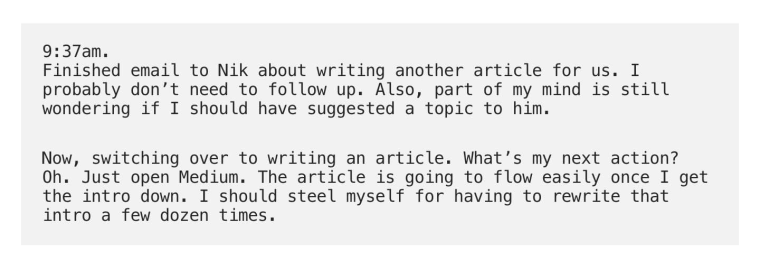To-do lists are great for managing projects. One way to make them even better is what CEO and productivity coach Tony Stubblebine calls “interstitial journaling”— the practice of making short journal entries between tasks.

“I use it for focus, I use it to work smarter,” says Stubblebine, who first introduced the concept in a Better Humans - Medium.com article in 2017.
Think of it this way: Instead of simply writing down a list of projects you need to get done and checking them off as you finish them, you’re building a strategic narrative around your workflow as you go.
“It just puts you in a position where you’re not distracted by what you just had been working on, and where you can be really strategic about what you’re about to work on,” Stubblebine tells NBC News BETTER.
Here’s how it works:
1) Write down the time you started and completed the task.
“For whatever reason, people like to look back on their journal,” Stubblebine says. “Seeing what time they were working on various tasks, it helps them see the structure of their day.”
Want a BETTER inbox? Sign up for our newsletter to make the most of your mind, your body and your life
2) Write a few sentences about what you just worked on and how it went.
“That’s about clearing your mind of the clutter of the last task,” says Stubblebine. “Your goal should be to be done-done with that, not to be still thinking about it as you move onto the next thing.”
Stubblebine, Brooklyn-based founder and CEO of the coaching app Coach.me, says he uses his journal entries as an opportunity to reflect on distractions he experiences during his work day.
“I use it to overcome procrastination all the time,” he says. “It’s a major question I ask myself in the journal is, ‘Do I have resistance to my next project or my next task, and why? And how do I get out of that?’ So, I’ll do a little introspection about procrastination as a way to try to work my way past that.”

3) Write down the “first action” for your next project.
Stubblebine says “first action” builds on a similar concept called “next action” coined by David Allen in his popular productivity book “Getting Things Done: The Art of Stress-Free Productivity”. Instead of writing down the name of the project you need to get done, you’re going to write down the very first thing you need to do to get it started.
For example, instead of writing “Create PowerPoint Presentation,” you’re going to write “Open PowerPoint.”

It’s a simple psychological trick, according to Stubblebine: “First action” to-do’s seem less like overwhelming projects we need to finish, and more like easy tasks, so we have less resistance to doing them.
“That’s about setting yourself up to have a smart strategy to approach your next bit of work,” Stubblebine says.
How to get started with interstitial journaling
- Stubblebine recommends using whatever journal you already use for your to dos. “Whether it’s paper or an app, it doesn’t matter, you don’t have to optimize for that,” he says.
- Focus on making your journal entries short. “This isn’t like a three page journal entry,” Stubblebine says. “This could be a four sentence journal entry.”
- Make your journal flexible, he says, so you can evolve it to fit your needs. “You know where you tend to get tripped up,” Stubblebine says. “The journal entry is an opportunity for you to self reflect in the way you know you need to self reflect.”
MORE TIPS FOR A BETTER DAY
- 9 things to do this morning to make your whole day more productive
- 12 tips to master your kids' morning routine and eliminate stress
- The productivity hack that allowed me to accomplish more in less time
- How the '2-minute rule' can help you get more done today
Want more tips like these? NBC News BETTER is obsessed with finding easier, healthier and smarter ways to live. Sign up for our newsletter and follow us on Facebook, Twitter and Instagram.

